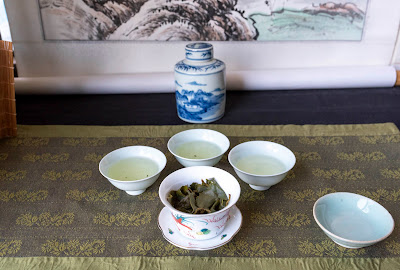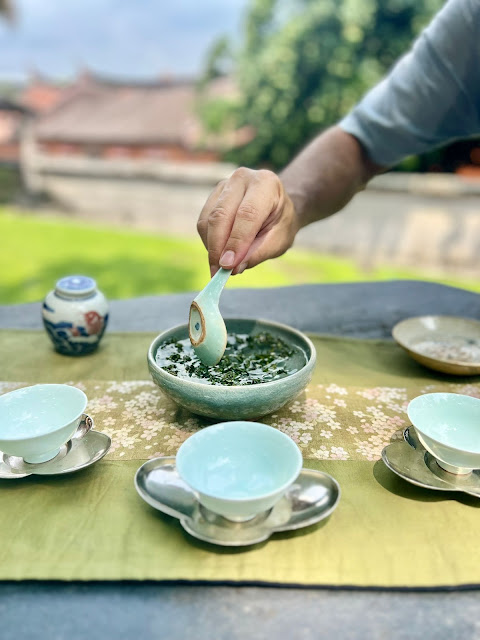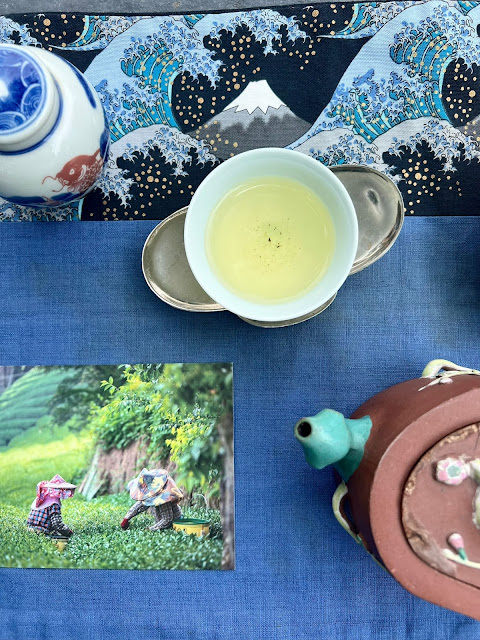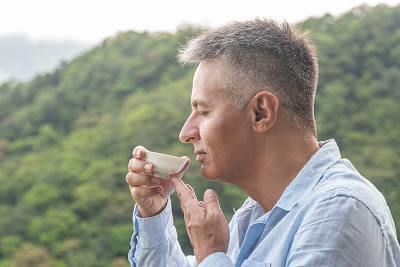 |
| Fo Shou Baozhong |
The confusion over these 2 names, Oolong and Baozhong, comes from the multiple meanings of Oolong and the many kinds of Baozhongs and their similar flavors.
In order to clarify things, let's start with 'Baozhong'包種 which is phonetically derived from 包中 and means 'packed inside'. It comes from the way tea used to be packed inside a sheet of paper at the end of the 19th century in northern Taiwan (about in the 1880s). At that time, this described semi-oxidized and roasted single tea leaves made in the same manner as in Wuyi, in the Fujian province.
The name Wenshan existed already during the Japanese era (1895-1945) and described the area from south of Taipei, XinDian to Pinglin. However, in the early 20th century (1901-1903), this Wenshan area was 4th in the volume of Baozhong produced. At the top spot you had the TaoJian bao (from Taoyuan/Jiantan/Linkou to Chungli), then came ShiDing bao (including Keelung) and third BaiJie bao (Banciao, ChungHo, Tucheng). So, Wenshan Baozhong only became the standard name for Baozhong when Baozhong production had receded in the other 3 regions in the 1960s.
So, the name Wenshan Baozhong means that this is a semi-oxidized tea produced in the Wenshan area in northern Taiwan. The shape of its leaves should be straight or twisted and not rolled. And farmers can use any kind of tea cultivar they wish to produce their Baozhong.
The name Oolong
烏龍 (black dragon) has several meanings in Taiwan. Originally, it poetically described the shape and color of Wuyi tea leaves or a Baozhong leaf nowadays. It can mean a process and can be used to describe any semi-oxidized tea. That's why Baozhong is part of the Oolong tea category, because it's semi-oxidized.
However, the name Oolong can also mean a cultivar in Taiwan, the Qingxin Oolong cultivar.
And finally, the name Oolong can also be meant in opposition to Baozhong and describe a leaf that is rolled instead of one that is twisted!
So, a Baozhong tea can use a Oolong cultivar and it's part of the Oolong (semi-oxidized) tea category, but it can never be rolled like a (high mountain or Dong Ding) Oolong. If a Wenshan farmer rolls his tea leaves, they have to be called Oolong, even if he packs them in a sheet of paper!
Now that we have clarified the words, we can turn to the brew and try to put words to differentiate Baozhong from Oolong. First, Baozhong brings a lightness where Oolongs are usually more concentrated. Second, and this
Fo Shou Baozhong is a great example, fresh, unroasted Baozhongs often have a citrus note that adds a zesty flavor to the brew, where high mountain Oolongs tend to be sweeter and more powerful.
Third, Wenshan Baozhongs are also more unpredictable and full of surprises depending on which cultivar it is made from and how well it was dried. Rolled Oolong leaves can be tightly vacuum-sealed and keep their fresh flavors for several years. With
Baozhong, some air will always be present in the pack and hasten the aging process. This means a tea that is very alive and changing! It can be a weakness, but it can also be a strength as some tea friends shared their wonderful experiences of tasting Baozhongs they had purchased over 10 years ago from my selection!
Have a clear mind when you drink tea. It starts by learning what exactly you are drinking: what cultivar, what region, what process, what season and what year it's from.

















































